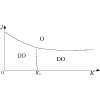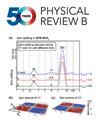Uncovering gauge-dependent critical order-parameter correlations by a stochastic gauge fixing at O(N)* and Ising* continuous transitions
IF 3.7
2区 物理与天体物理
Q1 Physics and Astronomy
引用次数: 0
Abstract
We study the transitions that occur in the 3D -gauge -vector model and the analogous transitions occurring in the 3D -gauge Higgs model, corresponding to the -gauge -vector model with . At these transitions, gauge-invariant correlations behave as in the usual -vector (Ising for ) model. Instead, the non-gauge-invariant spin correlations are trivial and therefore the spin order parameter that characterizes the spontaneous breaking of the symmetry in standard -vector (Ising) systems is apparently absent. We define a gauge fixing procedure—we name it stochastic gauge fixing—that allows us to define a gauge-dependent vector field that orders at the transition and is therefore the appropriate order parameter for the symmetry breaking. To substantiate this approach, we perform numerical simulations for and . A finite-size scaling analysis of the numerical data allows us to confirm the general scenario: the gauge-fixed spin correlation functions behave as the corresponding functions computed in the usual -vector (Ising) model. The emergence of a critical vector order parameter in the gauge model shows the complete equivalence of the () and (Ising) universality classes.

在 O(N)* 和 Ising* 连续跃迁中通过随机规固定揭示规依赖临界阶参数相关性
我们研究了发生在三维 Z2 轨 N 向量模型中的 O(N)* 转变,以及发生在三维 Z2 轨希格斯模型中的类似 Ising* 转变,它们对应于 N=1 的 Z2 轨 N 向量模型。在这些转换中,量规不变相关性的表现与通常的 N 向量(N=1 时为 Ising)模型相同。相反,非规不变的自旋相关性是微不足道的,因此在标准 N 向量(伊星)系统中表征 O(N)对称性自发破缺的自旋阶参数显然不存在。我们定义了一种轨距固定程序--我们称之为随机轨距固定--它允许我们定义一个与轨距相关的矢量场,该矢量场在转换时有序,因此是 O(N) 对称性破缺的适当阶次参数。为了证实这种方法,我们对 N=3 和 N=1 进行了数值模拟。通过对数值数据的有限大小缩放分析,我们证实了一般情况:规固定自旋相关函数的表现与通常的 N 向量(伊辛)模型中计算的相应函数相同。量规模型中临界矢量阶参数的出现表明了 O(N)*(伊辛*)和 O(N)(伊辛)普遍性类别的完全等价性。
本文章由计算机程序翻译,如有差异,请以英文原文为准。
求助全文
约1分钟内获得全文
求助全文
来源期刊

Physical Review B
物理-物理:凝聚态物理
CiteScore
6.70
自引率
32.40%
发文量
0
审稿时长
3.0 months
期刊介绍:
Physical Review B (PRB) is the world’s largest dedicated physics journal, publishing approximately 100 new, high-quality papers each week. The most highly cited journal in condensed matter physics, PRB provides outstanding depth and breadth of coverage, combined with unrivaled context and background for ongoing research by scientists worldwide.
PRB covers the full range of condensed matter, materials physics, and related subfields, including:
-Structure and phase transitions
-Ferroelectrics and multiferroics
-Disordered systems and alloys
-Magnetism
-Superconductivity
-Electronic structure, photonics, and metamaterials
-Semiconductors and mesoscopic systems
-Surfaces, nanoscience, and two-dimensional materials
-Topological states of matter
 求助内容:
求助内容: 应助结果提醒方式:
应助结果提醒方式:


